rims Seat Alhambra 2010 User Guide
[x] Cancel search | Manufacturer: SEAT, Model Year: 2010, Model line: Alhambra, Model: Seat Alhambra 2010Pages: 413, PDF Size: 3.86 MB
Page 327 of 413
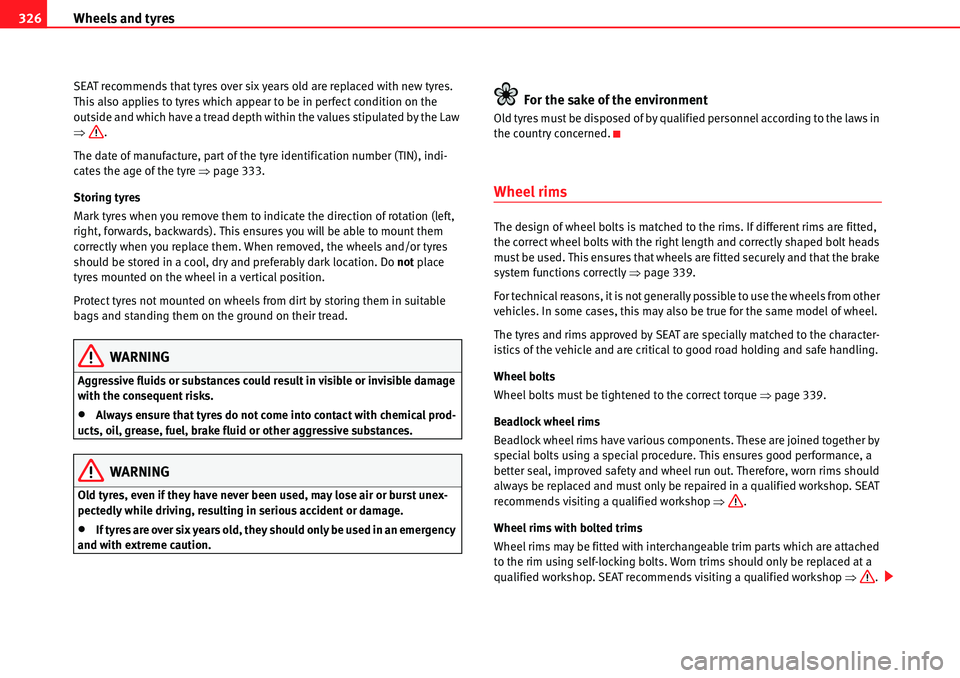
Wheels and tyres 326
SEAT recommends that tyres over six years old are replaced with new tyres.
This also applies to tyres which appear to be in perfect condition on the
outside and which have a tread depth within the values stipulated by the Law
�Ÿ.
The date of manufacture, part of the tyre identification number (TIN), indi-
cates the age of the tyre �Ÿpage 333.
Storing tyres
Mark tyres when you remove them to indicate the direction of rotation (left,
right, forwards, backwards). This ensures you will be able to mount them
correctly when you replace them. When removed, the wheels and/or tyres
should be stored in a cool, dry and preferably dark location. Do not place
tyres mounted on the wheel in a vertical position.
Protect tyres not mounted on wheels from dirt by storing them in suitable
bags and standing them on the ground on their tread.
WARNING
Aggressive fluids or substances could result in visible or invisible damage
with the consequent risks.
�xAlways ensure that tyres do not come into contact with chemical prod-
ucts, oil, grease, fuel, brake fluid or other aggressive substances.
WARNING
Old tyres, even if they have never been used, may lose air or burst unex-
pectedly while driving, resulting in serious accident or damage.
�xIf tyres are over six years old, they should only be used in an emergency
and with extreme caution.
For the sake of the environment
Old tyres must be disposed of by qualified personnel according to the laws in
the country concerned.
Wheel rims
The design of wheel bolts is matched to the rims. If different rims are fitted,
the correct wheel bolts with the right length and correctly shaped bolt heads
must be used. This ensures that wheels are fitted securely and that the brake
system functions correctly �Ÿpage 339.
For technical reasons, it is not generally possible to use the wheels from other
vehicles. In some cases, this may also be true for the same model of wheel.
The tyres and rims approved by SEAT are specially matched to the character-
istics of the vehicle and are critical to good road holding and safe handling.
Wheel bolts
Wheel bolts must be tightened to the correct torque �Ÿpage 339.
Beadlock wheel rims
Beadlock wheel rims have various components. These are joined together by
special bolts using a special procedure. This ensures good performance, a
better seal, improved safety and wheel run out. Therefore, worn rims should
always be replaced and must only be repaired in a qualified workshop. SEAT
recommends visiting a qualified workshop �Ÿ.
Wheel rims with bolted trims
Wheel rims may be fitted with interchangeable trim parts which are attached
to the rim using self-locking bolts. Worn trims should only be replaced at a
qualified workshop. SEAT recommends visiting a qualified workshop �Ÿ.
Page 328 of 413
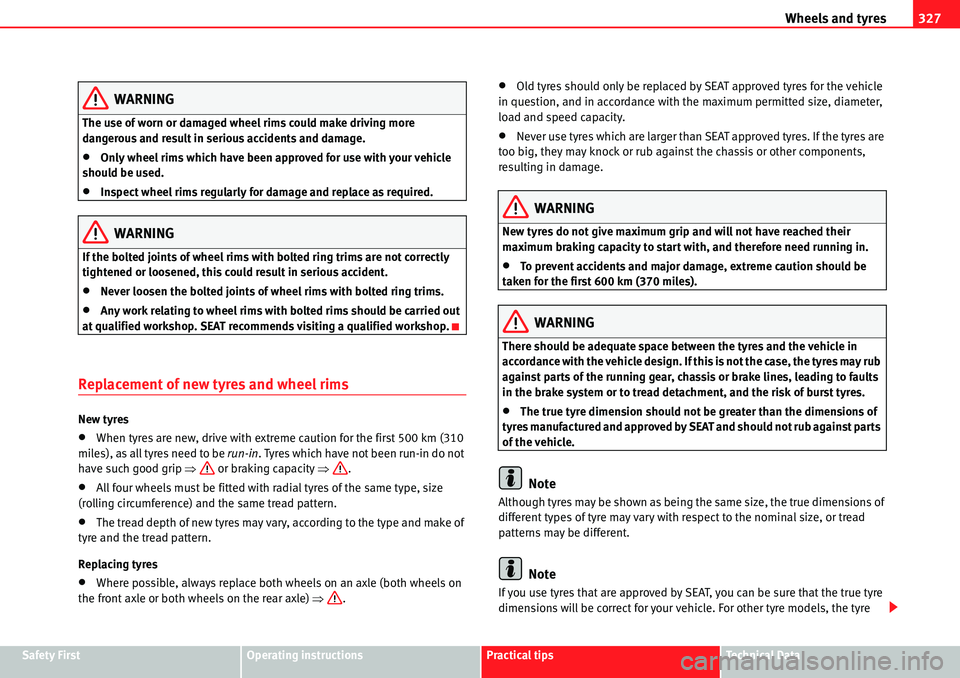
Wheels and tyres327
Safety FirstOperating instructionsPractical tipsTe c h n i c a l D a t a
WARNING
The use of worn or damaged wheel rims could make driving more
dangerous and result in serious accidents and damage.
�xOnly wheel rims which have been approved for use with your vehicle
should be used.
�xInspect wheel rims regularly for damage and replace as required.
WARNING
If the bolted joints of wheel rims with bolted ring trims are not correctly
tightened or loosened, this could result in serious accident.
�xNever loosen the bolted joints of wheel rims with bolted ring trims.
�xAny work relating to wheel rims with bolted rims should be carried out
at qualified workshop. SEAT recommends visiting a qualified workshop.
Replacement of new tyres and wheel rims
New tyres
�xWhen tyres are new, drive with extreme caution for the first 500 km (310
miles), as all tyres need to be run-in. Tyres which have not been run-in do not
have such good grip �Ÿ or braking capacity �Ÿ.
�xAll four wheels must be fitted with radial tyres of the same type, size
(rolling circumference) and the same tread pattern.
�xThe tread depth of new tyres may vary, according to the type and make of
tyre and the tread pattern.
Replacing tyres
�xWhere possible, always replace both wheels on an axle (both wheels on
the front axle or both wheels on the rear axle) �Ÿ.
�xOld tyres should only be replaced by SEAT approved tyres for the vehicle
in question, and in accordance with the maximum permitted size, diameter,
load and speed capacity.
�xNever use tyres which are larger than SEAT approved tyres. If the tyres are
too big, they may knock or rub against the chassis or other components,
resulting in damage.
WARNING
New tyres do not give maximum grip and will not have reached their
maximum braking capacity to start with, and therefore need running in.
�xTo prevent accidents and major damage, extreme caution should be
taken for the first 600 km (370 miles).
WARNING
There should be adequate space between the tyres and the vehicle in
accordance with the vehicle design. If this is not the case, the tyres may rub
against parts of the running gear, chassis or brake lines, leading to faults
in the brake system or to tread detachment, and the risk of burst tyres.
�xThe true tyre dimension should not be greater than the dimensions of
tyres manufactured and approved by SEAT and should not rub against parts
of the vehicle.
Note
Although tyres may be shown as being the same size, the true dimensions of
different types of tyre may vary with respect to the nominal size, or tread
patterns may be different.
Note
If you use tyres that are approved by SEAT, you can be sure that the true tyre
dimensions will be correct for your vehicle. For other tyre models, the tyre
Page 333 of 413
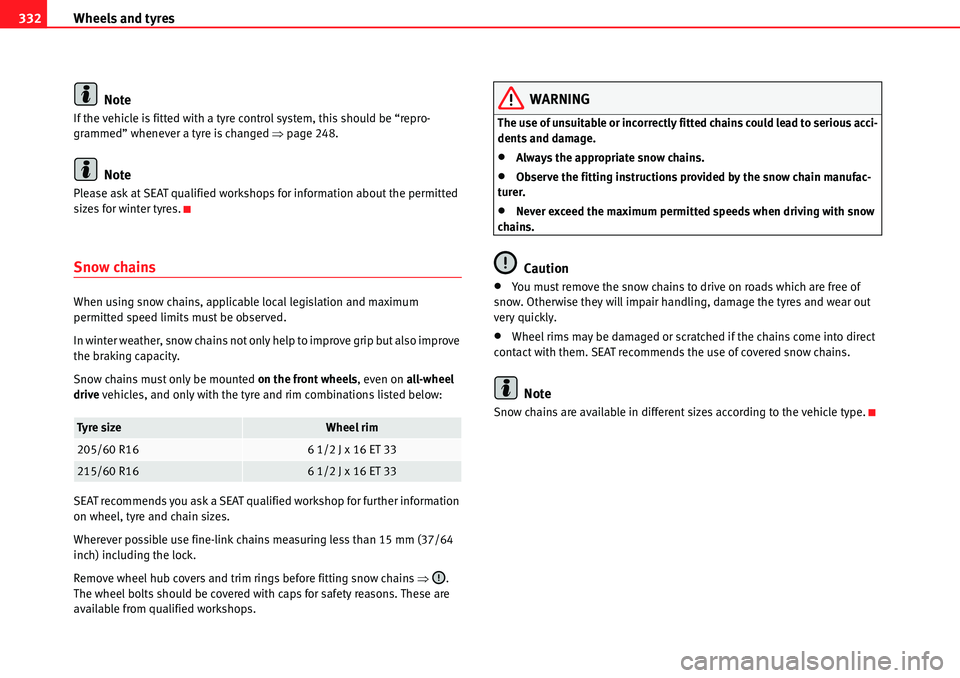
Wheels and tyres 332
Note
If the vehicle is fitted with a tyre control system, this should be “repro-
grammed” whenever a tyre is changed �Ÿpage 248.
Note
Please ask at SEAT qualified workshops for information about the permitted
sizes for winter tyres.
Snow chains
When using snow chains, applicable local legislation and maximum
permitted speed limits must be observed.
In winter weather, snow chains not only help to improve grip but also improve
the braking capacity.
Snow chains must only be mounted on the front wheels, even on all-wheel
drive vehicles, and only with the tyre and rim combinations listed below:
SEAT recommends you ask a SEAT qualified workshop for further information
on wheel, tyre and chain sizes.
Wherever possible use fine-link chains measuring less than 15 mm (37/64
inch) including the lock.
Remove wheel hub covers and trim rings before fitting snow chains �Ÿ.
The wheel bolts should be covered with caps for safety reasons. These are
available from qualified workshops.
WARNING
The use of unsuitable or incorrectly fitted chains could lead to serious acci-
dents and damage.
�xAlways the appropriate snow chains.
�xObserve the fitting instructions provided by the snow chain manufac-
turer.
�xNever exceed the maximum permitted speeds when driving with snow
chains.
Caution
�xYou must remove the snow chains to drive on roads which are free of
snow. Otherwise they will impair handling, damage the tyres and wear out
very quickly.
�xWheel rims may be damaged or scratched if the chains come into direct
contact with them. SEAT recommends the use of covered snow chains.
Note
Snow chains are available in different sizes according to the vehicle type.Tyre sizeWheel rim
205/60 R166 1/2 J x 16 ET 33
215/60 R166 1/2 J x 16 ET 33
Page 337 of 413
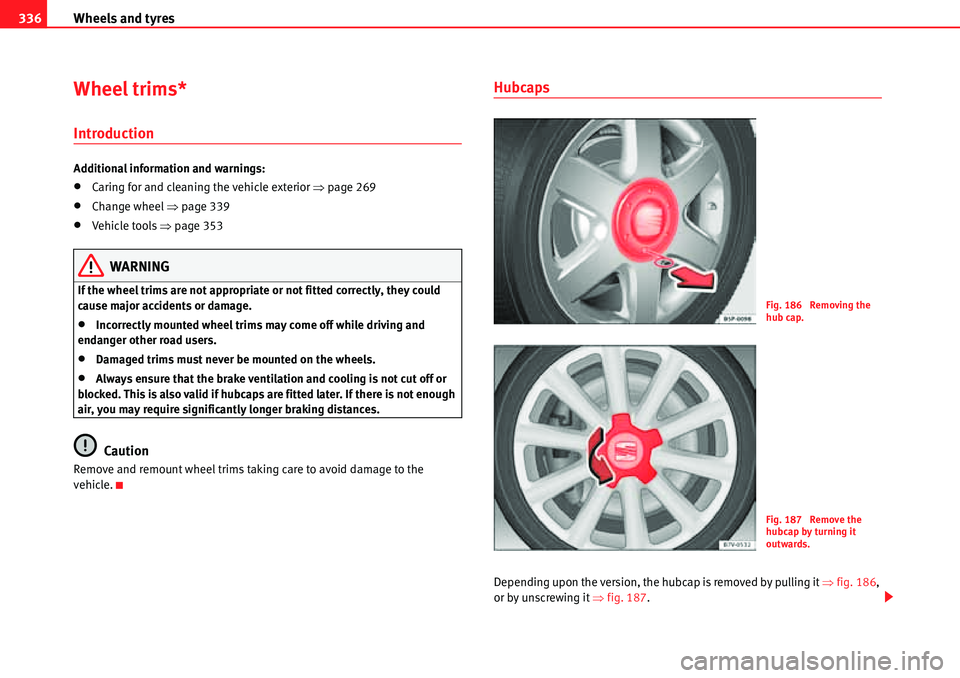
Wheels and tyres 336
Wheel trims*
Introduction
Additional information and warnings:
�xCaring for and cleaning the vehicle exterior �Ÿpage 269
�xChange wheel �Ÿpage 339
�xVehicle tools �Ÿpage 353
WARNING
If the wheel trims are not appropriate or not fitted correctly, they could
cause major accidents or damage.
�xIncorrectly mounted wheel trims may come off while driving and
endanger other road users.
�xDamaged trims must never be mounted on the wheels.
�xAlways ensure that the brake ventilation and cooling is not cut off or
blocked. This is also valid if hubcaps are fitted later. If there is not enough
air, you may require significantly longer braking distances.
Caution
Remove and remount wheel trims taking care to avoid damage to the
vehicle.
Hubcaps
Depending upon the version, the hubcap is removed by pulling it �Ÿfig. 186,
or by unscrewing it �Ÿfig. 187.
Fig. 186 Removing the
hub cap.
Fig. 187 Remove the
hubcap by turning it
outwards.
Page 340 of 413
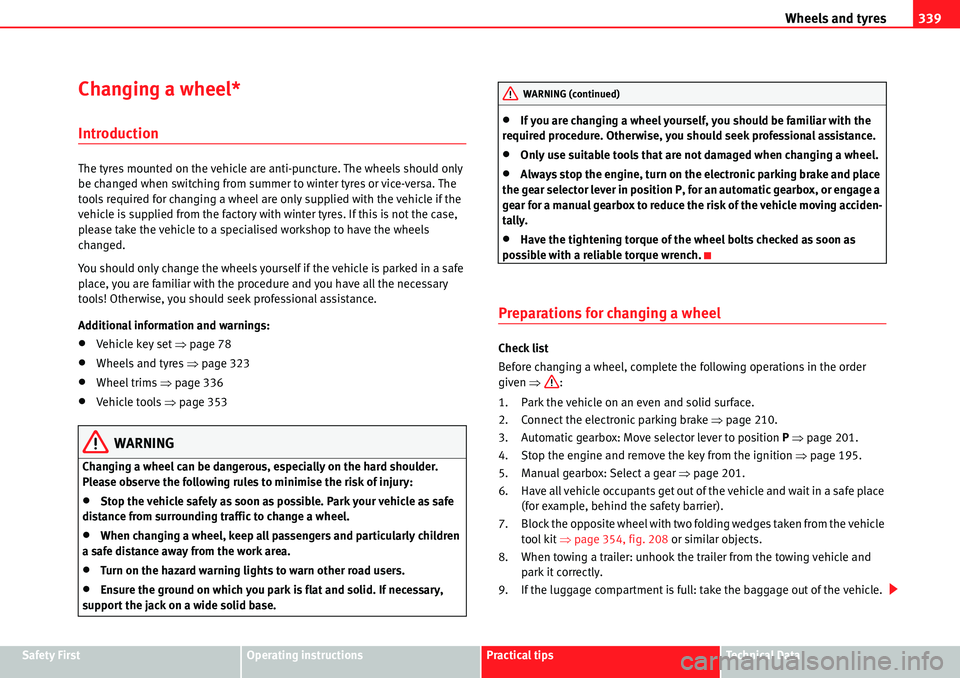
Wheels and tyres339
Safety FirstOperating instructionsPractical tipsTe c h n i c a l D a t a
Changing a wheel*
Introduction
The tyres mounted on the vehicle are anti-puncture. The wheels should only
be changed when switching from summer to winter tyres or vice-versa. The
tools required for changing a wheel are only supplied with the vehicle if the
vehicle is supplied from the factory with winter tyres. If this is not the case,
please take the vehicle to a specialised workshop to have the wheels
changed.
You should only change the wheels yourself if the vehicle is parked in a safe
place, you are familiar with the procedure and you have all the necessary
tools! Otherwise, you should seek professional assistance.
Additional information and warnings:
�xVehicle key set �Ÿpage 78
�xWheels and tyres �Ÿpage 323
�xWheel trims �Ÿpage 336
�xVehicle tools �Ÿpage 353
WARNING
Changing a wheel can be dangerous, especially on the hard shoulder.
Please observe the following rules to minimise the risk of injury:
�xStop the vehicle safely as soon as possible. Park your vehicle as safe
distance from surrounding traffic to change a wheel.
�xWhen changing a wheel, keep all passengers and particularly children
a safe distance away from the work area.
�xTurn on the hazard warning lights to warn other road users.
�xEnsure the ground on which you park is flat and solid. If necessary,
support the jack on a wide solid base.
�xIf you are changing a wheel yourself, you should be familiar with the
required procedure. Otherwise, you should seek professional assistance.
�xOnly use suitable tools that are not damaged when changing a wheel.
�xAlways stop the engine, turn on the electronic parking brake and place
the gear selector lever in position P, for an automatic gearbox, or engage a
gear for a manual gearbox to reduce the risk of the vehicle moving acciden-
tally.
�xHave the tightening torque of the wheel bolts checked as soon as
possible with a reliable torque wrench.
Preparations for changing a wheel
Check list
Before changing a wheel, complete the following operations in the order
given �Ÿ:
1. Park the vehicle on an even and solid surface.
2. Connect the electronic parking brake �Ÿpage 210.
3. Automatic gearbox: Move selector lever to position P �Ÿpage 201.
4. Stop the engine and remove the key from the ignition �Ÿpage 195.
5. Manual gearbox: Select a gear �Ÿpage 201.
6. Have all vehicle occupants get out of the vehicle and wait in a safe place
(for example, behind the safety barrier).
7. Block the opposite wheel with two folding wedges taken from the vehicle
tool kit �Ÿpage 354, fig. 208 or similar objects.
8. When towing a trailer: unhook the trailer from the towing vehicle and
park it correctly.
9. If the luggage compartment is full: take the baggage out of the vehicle.
WARNING (continued)
Page 341 of 413
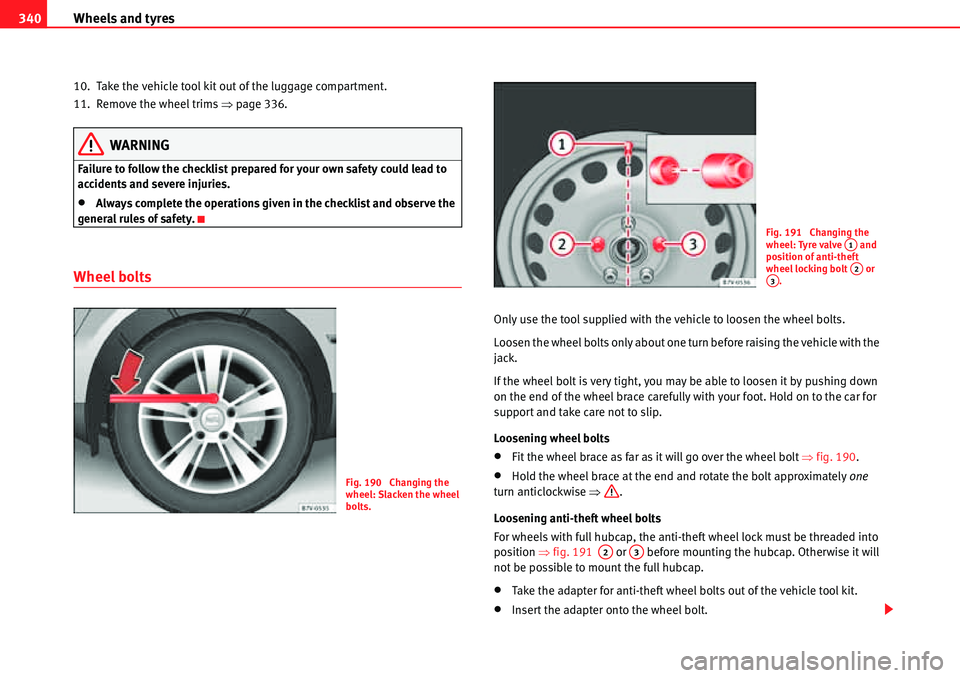
Wheels and tyres 340
10. Take the vehicle tool kit out of the luggage compartment.
11. Remove the wheel trims �Ÿpage 336.
WARNING
Failure to follow the checklist prepared for your own safety could lead to
accidents and severe injuries.
�xAlways complete the operations given in the checklist and observe the
general rules of safety.
Wheel bolts
Only use the tool supplied with the vehicle to loosen the wheel bolts.
Loosen the wheel bolts only about one turn before raising the vehicle with the
jack.
If the wheel bolt is very tight, you may be able to loosen it by pushing down
on the end of the wheel brace carefully with your foot. Hold on to the car for
support and take care not to slip.
Loosening wheel bolts
�xFit the wheel brace as far as it will go over the wheel bolt �Ÿfig. 190.
�xHold the wheel brace at the end and rotate the bolt approximately one
turn anticlockwise �Ÿ.
Loosening anti-theft wheel bolts
For wheels with full hubcap, the anti-theft wheel lock must be threaded into
position �Ÿfig. 191 or before mounting the hubcap. Otherwise it will
not be possible to mount the full hubcap.
�xTake the adapter for anti-theft wheel bolts out of the vehicle tool kit.
�xInsert the adapter onto the wheel bolt.
Fig. 190 Changing the
wheel: Slacken the wheel
bolts.
Fig. 191 Changing the
wheel: Tyre valve and
position of anti-theft
wheel locking bolt or
.A1
A2A3
A2A3
Page 342 of 413
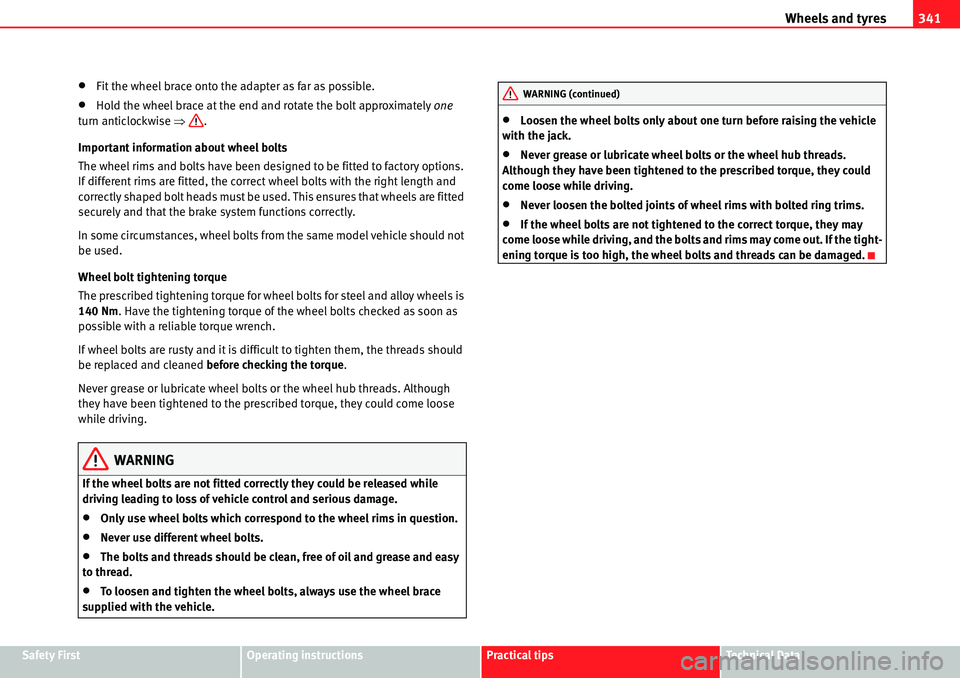
Wheels and tyres341
Safety FirstOperating instructionsPractical tipsTe c h n i c a l D a t a
�xFit the wheel brace onto the adapter as far as possible.
�xHold the wheel brace at the end and rotate the bolt approximately one
turn anticlockwise �Ÿ.
Important information about wheel bolts
The wheel rims and bolts have been designed to be fitted to factory options.
If different rims are fitted, the correct wheel bolts with the right length and
correctly shaped bolt heads must be used. This ensures that wheels are fitted
securely and that the brake system functions correctly.
In some circumstances, wheel bolts from the same model vehicle should not
be used.
Wheel bolt tightening torque
The prescribed tightening torque for wheel bolts for steel and alloy wheels is
140 Nm. Have the tightening torque of the wheel bolts checked as soon as
possible with a reliable torque wrench.
If wheel bolts are rusty and it is difficult to tighten them, the threads should
be replaced and cleaned before checking the torque.
Never grease or lubricate wheel bolts or the wheel hub threads. Although
they have been tightened to the prescribed torque, they could come loose
while driving.
WARNING
If the wheel bolts are not fitted correctly they could be released while
driving leading to loss of vehicle control and serious damage.
�xOnly use wheel bolts which correspond to the wheel rims in question.
�xNever use different wheel bolts.
�xThe bolts and threads should be clean, free of oil and grease and easy
to thread.
�xTo loosen and tighten the wheel bolts, always use the wheel brace
supplied with the vehicle.
�xLoosen the wheel bolts only about one turn before raising the vehicle
with the jack.
�xNever grease or lubricate wheel bolts or the wheel hub threads.
Although they have been tightened to the prescribed torque, they could
come loose while driving.
�xNever loosen the bolted joints of wheel rims with bolted ring trims.
�xIf the wheel bolts are not tightened to the correct torque, they may
come loose while driving, and the bolts and rims may come out. If the tight-
ening torque is too high, the wheel bolts and threads can be damaged.
WARNING (continued)
Page 410 of 413
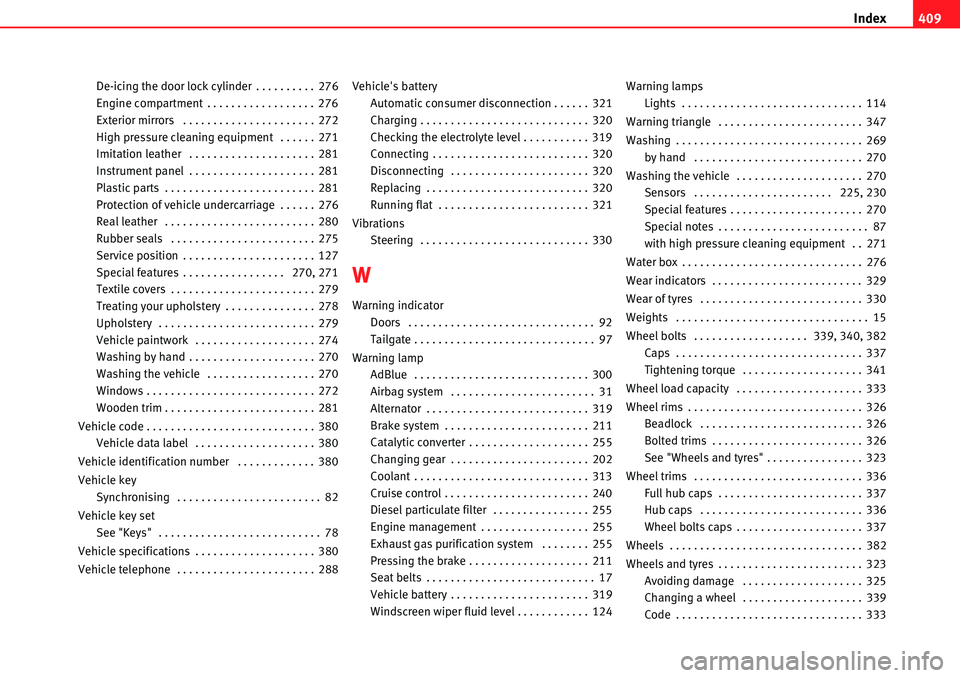
Index409
De-icing the door lock cylinder . . . . . . . . . . 276
Engine compartment . . . . . . . . . . . . . . . . . . 276
Exterior mirrors . . . . . . . . . . . . . . . . . . . . . . 272
High pressure cleaning equipment . . . . . . 271
Imitation leather . . . . . . . . . . . . . . . . . . . . . 281
Instrument panel . . . . . . . . . . . . . . . . . . . . . 281
Plastic parts . . . . . . . . . . . . . . . . . . . . . . . . . 281
Protection of vehicle undercarriage . . . . . . 276
Real leather . . . . . . . . . . . . . . . . . . . . . . . . . 280
Rubber seals . . . . . . . . . . . . . . . . . . . . . . . . 275
Service position . . . . . . . . . . . . . . . . . . . . . . 127
Special features . . . . . . . . . . . . . . . . . 270, 271
Textile covers . . . . . . . . . . . . . . . . . . . . . . . . 279
Treating your upholstery . . . . . . . . . . . . . . . 278
Upholstery . . . . . . . . . . . . . . . . . . . . . . . . . . 279
Vehicle paintwork . . . . . . . . . . . . . . . . . . . . 274
Washing by hand . . . . . . . . . . . . . . . . . . . . . 270
Washing the vehicle . . . . . . . . . . . . . . . . . . 270
Windows . . . . . . . . . . . . . . . . . . . . . . . . . . . . 272
Wooden trim . . . . . . . . . . . . . . . . . . . . . . . . . 281
Vehicle code . . . . . . . . . . . . . . . . . . . . . . . . . . . . 380
Vehicle data label . . . . . . . . . . . . . . . . . . . . 380
Vehicle identification number . . . . . . . . . . . . . 380
Vehicle key
Synchronising . . . . . . . . . . . . . . . . . . . . . . . . 82
Vehicle key set
See "Keys" . . . . . . . . . . . . . . . . . . . . . . . . . . . 78
Vehicle specifications . . . . . . . . . . . . . . . . . . . . 380
Vehicle telephone . . . . . . . . . . . . . . . . . . . . . . . 288Vehicle's battery
Automatic consumer disconnection . . . . . . 321
Charging . . . . . . . . . . . . . . . . . . . . . . . . . . . . 320
Checking the electrolyte level . . . . . . . . . . . 319
Connecting . . . . . . . . . . . . . . . . . . . . . . . . . . 320
Disconnecting . . . . . . . . . . . . . . . . . . . . . . . 320
Replacing . . . . . . . . . . . . . . . . . . . . . . . . . . . 320
Running flat . . . . . . . . . . . . . . . . . . . . . . . . . 321
Vibrations
Steering . . . . . . . . . . . . . . . . . . . . . . . . . . . . 330
W
Warning indicator
Doors . . . . . . . . . . . . . . . . . . . . . . . . . . . . . . . 92
Tailgate . . . . . . . . . . . . . . . . . . . . . . . . . . . . . . 97
Warning lamp
AdBlue . . . . . . . . . . . . . . . . . . . . . . . . . . . . . 300
Airbag system . . . . . . . . . . . . . . . . . . . . . . . . 31
Alternator . . . . . . . . . . . . . . . . . . . . . . . . . . . 319
Brake system . . . . . . . . . . . . . . . . . . . . . . . . 211
Catalytic converter . . . . . . . . . . . . . . . . . . . . 255
Changing gear . . . . . . . . . . . . . . . . . . . . . . . 202
Coolant . . . . . . . . . . . . . . . . . . . . . . . . . . . . . 313
Cruise control . . . . . . . . . . . . . . . . . . . . . . . . 240
Diesel particulate filter . . . . . . . . . . . . . . . . 255
Engine management . . . . . . . . . . . . . . . . . . 255
Exhaust gas purification system . . . . . . . . 255
Pressing the brake . . . . . . . . . . . . . . . . . . . . 211
Seat belts . . . . . . . . . . . . . . . . . . . . . . . . . . . . 17
Vehicle battery . . . . . . . . . . . . . . . . . . . . . . . 319
Windscreen wiper fluid level . . . . . . . . . . . . 124Warning lamps
Lights . . . . . . . . . . . . . . . . . . . . . . . . . . . . . . 114
Warning triangle . . . . . . . . . . . . . . . . . . . . . . . . 347
Washing . . . . . . . . . . . . . . . . . . . . . . . . . . . . . . . 269
by hand . . . . . . . . . . . . . . . . . . . . . . . . . . . . 270
Washing the vehicle . . . . . . . . . . . . . . . . . . . . . 270
Sensors . . . . . . . . . . . . . . . . . . . . . . . 225, 230
Special features . . . . . . . . . . . . . . . . . . . . . . 270
Special notes . . . . . . . . . . . . . . . . . . . . . . . . . 87
with high pressure cleaning equipment . . 271
Water box . . . . . . . . . . . . . . . . . . . . . . . . . . . . . . 276
Wear indicators . . . . . . . . . . . . . . . . . . . . . . . . . 329
Wear of tyres . . . . . . . . . . . . . . . . . . . . . . . . . . . 330
Weights . . . . . . . . . . . . . . . . . . . . . . . . . . . . . . . . 15
Wheel bolts . . . . . . . . . . . . . . . . . . . 339, 340, 382
Caps . . . . . . . . . . . . . . . . . . . . . . . . . . . . . . . 337
Tightening torque . . . . . . . . . . . . . . . . . . . . 341
Wheel load capacity . . . . . . . . . . . . . . . . . . . . . 333
Wheel rims . . . . . . . . . . . . . . . . . . . . . . . . . . . . . 326
Beadlock . . . . . . . . . . . . . . . . . . . . . . . . . . . 326
Bolted trims . . . . . . . . . . . . . . . . . . . . . . . . . 326
See "Wheels and tyres" . . . . . . . . . . . . . . . . 323
Wheel trims . . . . . . . . . . . . . . . . . . . . . . . . . . . . 336
Full hub caps . . . . . . . . . . . . . . . . . . . . . . . . 337
Hub caps . . . . . . . . . . . . . . . . . . . . . . . . . . . 336
Wheel bolts caps . . . . . . . . . . . . . . . . . . . . . 337
Wheels . . . . . . . . . . . . . . . . . . . . . . . . . . . . . . . . 382
Wheels and tyres . . . . . . . . . . . . . . . . . . . . . . . . 323
Avoiding damage . . . . . . . . . . . . . . . . . . . . 325
Changing a wheel . . . . . . . . . . . . . . . . . . . . 339
Code . . . . . . . . . . . . . . . . . . . . . . . . . . . . . . . 333
Page 411 of 413
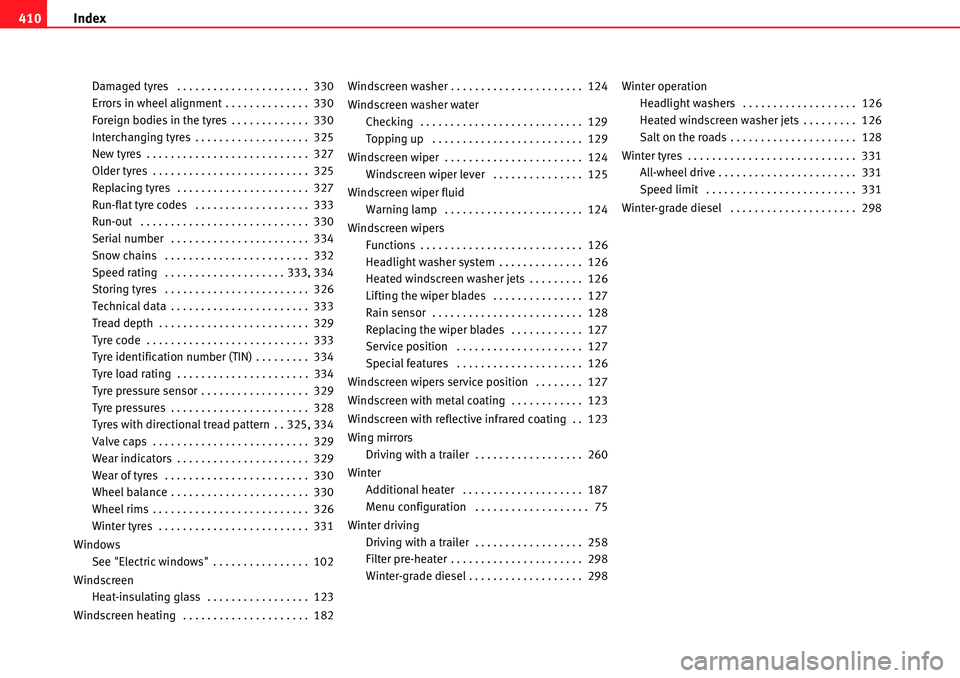
Index 410
Damaged tyres . . . . . . . . . . . . . . . . . . . . . . 330
Errors in wheel alignment . . . . . . . . . . . . . . 330
Foreign bodies in the tyres . . . . . . . . . . . . . 330
Interchanging tyres . . . . . . . . . . . . . . . . . . . 325
New tyres . . . . . . . . . . . . . . . . . . . . . . . . . . . 327
Older tyres . . . . . . . . . . . . . . . . . . . . . . . . . . 325
Replacing tyres . . . . . . . . . . . . . . . . . . . . . . 327
Run-flat tyre codes . . . . . . . . . . . . . . . . . . . 333
Run-out . . . . . . . . . . . . . . . . . . . . . . . . . . . . 330
Serial number . . . . . . . . . . . . . . . . . . . . . . . 334
Snow chains . . . . . . . . . . . . . . . . . . . . . . . . 332
Speed rating . . . . . . . . . . . . . . . . . . . . 333, 334
Storing tyres . . . . . . . . . . . . . . . . . . . . . . . . 326
Technical data . . . . . . . . . . . . . . . . . . . . . . . 333
Tread depth . . . . . . . . . . . . . . . . . . . . . . . . . 329
Tyre code . . . . . . . . . . . . . . . . . . . . . . . . . . . 333
Tyre identification number (TIN) . . . . . . . . . 334
Tyre load rating . . . . . . . . . . . . . . . . . . . . . . 334
Tyre pressure sensor . . . . . . . . . . . . . . . . . . 329
Tyre pressures . . . . . . . . . . . . . . . . . . . . . . . 328
Tyres with directional tread pattern . . 325, 334
Valve caps . . . . . . . . . . . . . . . . . . . . . . . . . . 329
Wear indicators . . . . . . . . . . . . . . . . . . . . . . 329
Wear of tyres . . . . . . . . . . . . . . . . . . . . . . . . 330
Wheel balance . . . . . . . . . . . . . . . . . . . . . . . 330
Wheel rims . . . . . . . . . . . . . . . . . . . . . . . . . . 326
Winter tyres . . . . . . . . . . . . . . . . . . . . . . . . . 331
Windows
See "Electric windows" . . . . . . . . . . . . . . . . 102
Windscreen
Heat-insulating glass . . . . . . . . . . . . . . . . . 123
Windscreen heating . . . . . . . . . . . . . . . . . . . . . 182Windscreen washer . . . . . . . . . . . . . . . . . . . . . . 124
Windscreen washer water
Checking . . . . . . . . . . . . . . . . . . . . . . . . . . . 129
Topping up . . . . . . . . . . . . . . . . . . . . . . . . . 129
Windscreen wiper . . . . . . . . . . . . . . . . . . . . . . . 124
Windscreen wiper lever . . . . . . . . . . . . . . . 125
Windscreen wiper fluid
Warning lamp . . . . . . . . . . . . . . . . . . . . . . . 124
Windscreen wipers
Functions . . . . . . . . . . . . . . . . . . . . . . . . . . . 126
Headlight washer system . . . . . . . . . . . . . . 126
Heated windscreen washer jets . . . . . . . . . 126
Lifting the wiper blades . . . . . . . . . . . . . . . 127
Rain sensor . . . . . . . . . . . . . . . . . . . . . . . . . 128
Replacing the wiper blades . . . . . . . . . . . . 127
Service position . . . . . . . . . . . . . . . . . . . . . 127
Special features . . . . . . . . . . . . . . . . . . . . . 126
Windscreen wipers service position . . . . . . . . 127
Windscreen with metal coating . . . . . . . . . . . . 123
Windscreen with reflective infrared coating . . 123
Wing mirrors
Driving with a trailer . . . . . . . . . . . . . . . . . . 260
Winter
Additional heater . . . . . . . . . . . . . . . . . . . . 187
Menu configuration . . . . . . . . . . . . . . . . . . . 75
Winter driving
Driving with a trailer . . . . . . . . . . . . . . . . . . 258
Filter pre-heater . . . . . . . . . . . . . . . . . . . . . . 298
Winter-grade diesel . . . . . . . . . . . . . . . . . . . 298Winter operation
Headlight washers . . . . . . . . . . . . . . . . . . . 126
Heated windscreen washer jets . . . . . . . . . 126
Salt on the roads . . . . . . . . . . . . . . . . . . . . . 128
Winter tyres . . . . . . . . . . . . . . . . . . . . . . . . . . . . 331
All-wheel drive . . . . . . . . . . . . . . . . . . . . . . . 331
Speed limit . . . . . . . . . . . . . . . . . . . . . . . . . 331
Winter-grade diesel . . . . . . . . . . . . . . . . . . . . . 298